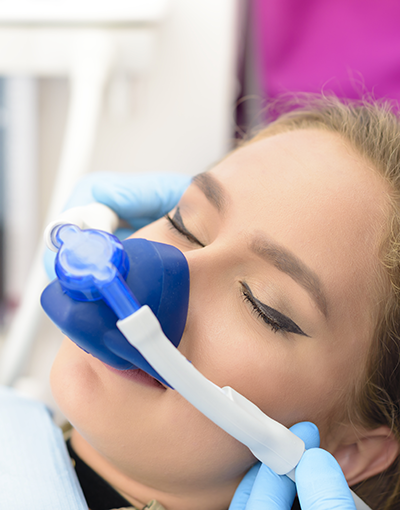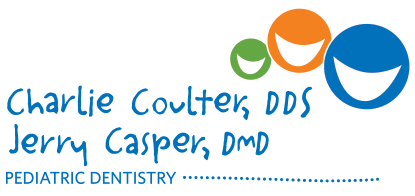
Hearing your child needs a dental procedure can be stressful, but thanks to our experts at Coulter & Casper Pediatric Dentistry here in Washington, D.C., sedation dentistry can help put those anxieties at ease.
Many are familiar with “laughing gas,” or Nitrous Oxide/Oxygen inhalation. “Laughing gas” is a mild, colorless, sweet-smelling form of sedative that allows dentists to calm patients and facilitate prolonged dental procedures. Nitrous oxide helps ease anxiety, reduce a hyperactive gag reflex, and increase a patient’s pain-reaction threshold, all while keeping the patient calm and comfortable for the procedure.
Using Sedation in Children’s Dentistry
Nitrous Oxide inhalation is a safe and effective method of sedation, plus it is non-allergenic and can be adjusted during the procedure. Laughing gas quickly relaxes the patient as they inhale the nitrous oxide through a small mask placed over their nose. Your child may feel sensations of euphoria, drowsiness, warmth and tingling of the hands and feet.
The risk of adverse effects is low, with less than 0.5% of young patients experiencing nausea or vomiting. The patient should also refrain from eating a large meal prior to breathing nitrous oxide. Parents are advised to keep their child from eating for 2 hours before the procedure to keep their child from getting sick while drowsy. Your child’s safety is our number 1 concern!
“Laughing gas” is not intended to put the patient to sleep and is never used as a general anesthetic during dental procedures. Nitrous oxide may be used in addition to local anesthesia, depending on the procedure and the individual needs of the patient.
To ensure your child has a positive experience and for nitrous oxide to be effective, it is important for your child to be feeling well and be able to breathe through his or her nose easily. Please contact us to reschedule if your child is experiencing a cold, fever, ear infection, or stuffy nose.
Nitrous oxide is quickly eliminated from the body, allowing for a fast recovery. Following a procedure, the patient will breathe oxygen for five minutes to lower the risk of a headache and decrease restrictions for aftercare.
Types of Sedation
While there are a few different types of sedation, your pediatric dentist will choose the best form of sedation necessary for your child’s procedure. Here are the different types of sedation used in pediatric dentistry:
- General Anesthesia: With general anesthesia, the patient will be completely asleep so as to feel no pain during the procedure. General anesthesia is administered by a specially trained anesthesia professional and operates independently from the dentist or oral surgeon facilitating the procedure. The anesthesia professional monitors the patient and adjusts the sedation level as needed. General anesthesia provides a pain-free experience for the patient throughout the procedure.
- Deep Sedation with IV: Deep sedation is administered through an IV to help patients sleep deeply during the procedure. Just like general anesthesia, deep sedation with an IV is administered and monitored by an anesthesia professional. Unlike general sedation, the patient may be able to move a little and make noises.
- Mild to Moderate Sedation: With mild to moderate sedation, the patient is calm and sleepy, while being able to hear the dentist, move, and remain responsive. Mild to moderate sedation is typically given orally and the patient will not need intubation for the procedure.
- Nitrous Oxide: Nitrous oxide, or laughing gas, is safe, quick, and effective for sedation in pediatric dentistry. As the least invasive form of sedation, laughing gas gives patients a warm, euphoric feeling during the procedure, while keeping the patient awake with a very rapid recovery following sedation.
Dr. Charlie and Dr. Jerry are happy to answer any questions regarding sedation dentistry at your next appointment.
Benefits of Using Nitrous Oxide in Pediatric Dentistry
Nitrous oxide inhalation is the least invasive sedative and provides a quick, easy way to decrease anxiety for a dental procedure. Nitrous oxide is very commonly used by dentists and is non-irritating to the tissue and non-allergenic. Your child’s comfort and safety is our goal at Coulter & Casper Pediatric Dentistry. We want parents to have peace of mind when it comes to your child’s dental procedure. If you have any questions about the use of nitrous oxide, please feel free to contact our office.
Is Nitrous Oxide Safe for Children?
Dental professionals consider nitrous oxide as the safest form of sedation. At Coulter & Casper Pediatric Dentistry, we follow the American Association of Pediatric Dentistry guidelines to ensure the safety of your child during his or her procedure. These guidelines require 2 medical professionals present during the procedure. One will be the dentist or oral surgeon conducting the procedure, the other will be an anesthesiologist or a certified registered nurse anesthetist to facilitate the sedation and monitor the patient.
Post Sedation Procedure Instructions
Following a procedure, your child may feel drowsiness, grogginess, and may experience mild pain from the dental procedure. Monitor your child after the procedure. Give your child soft foods like mashed potatoes, lukewarm soup, and smoothies to avoid any discomfort in the mouth. Also, encourage your child to stay hydrated and use an ice pack to reduce swelling. If you have any questions or concerns, contact our office to talk with a member of our team!

 Get directions to our office!
Get directions to our office!